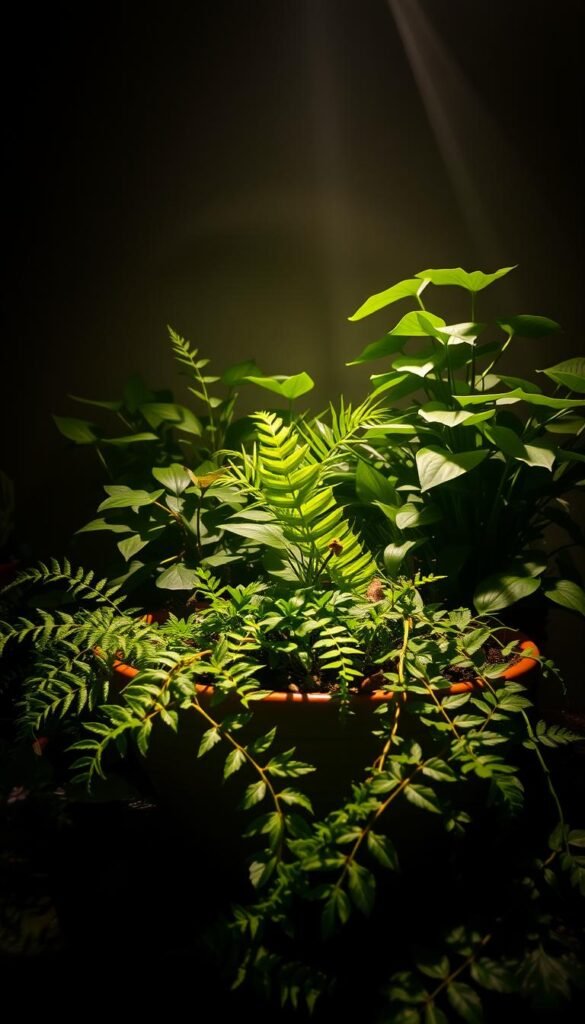Brightening dim spaces doesn’t require constant sunlight. With thoughtful plant choices, even the shadiest corners of your home can burst with life. Many varieties flourish under indirect light, offering colorful leaves and delicate blooms that add charm to any room.
You might think limited sunshine means fewer options, but nature provides plenty of solutions. Species adapted to forest floors or sheltered woodland edges bring unique textures and patterns to your arrangements. These selections often grow lush foliage that stays vibrant year-round, creating visual interest without relying on flowers.
Designing for shadowy spots means focusing on contrasts. Mix plants with broad, glossy leaves alongside those with feathery fronds or variegated patterns. This approach builds depth and movement in your containers, turning forgotten spaces into living art pieces.
Successful container gardening in low-light conditions starts with understanding each plant’s needs. Some prefer moist soil, while others thrive in drier setups. Pairing compatible species ensures your miniature ecosystem stays healthy and eye-catching through every season.
Understanding Your Shade Garden Conditions
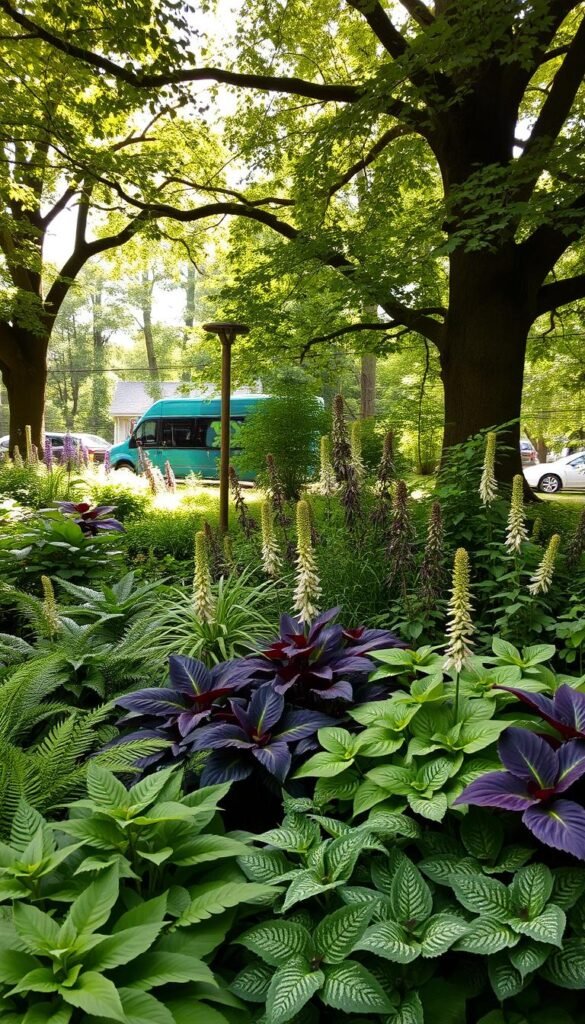
Creating a thriving green space starts with decoding your environment. Not all shadows behave the same—some areas filter soft light through leaves, while others stay dim all day. Recognizing these patterns helps you match plants to their perfect home.
Evaluating Light Exposure and Soil Needs
Track how sunlight moves through your space. Morning rays are milder, while afternoon beams pack more heat. Areas near buildings or under thick trees often get full shade, needing plants that thrive without direct sun. Use a simple trick: check spots every two hours to count sunlight hours.
Soil in shaded zones stays damp longer. Press your finger into the dirt—if it feels soggy, pick moisture-loving varieties. For dry shade under trees, consider drought-tolerant species. Pair these insights with best plants for low-light spots to build your ideal display.
Identifying Shady Corners in Your Garden
Watch where light dances and where it hides. North-facing walls receive gentle light, while east-facing spaces enjoy soft morning sun. Dappled shade under birch trees offers shifting patterns that many plants adore. True full shade areas need special attention—these are perfect for ferns and mosses.
Remember: afternoon shade protects plants from harsh rays, while morning shade keeps delicate leaves safe from sudden temperature spikes. Map your garden’s light zones seasonally—what’s shaded in summer might bask in winter sun.
Top Annuals for Vibrant Color in Low-Light Gardens
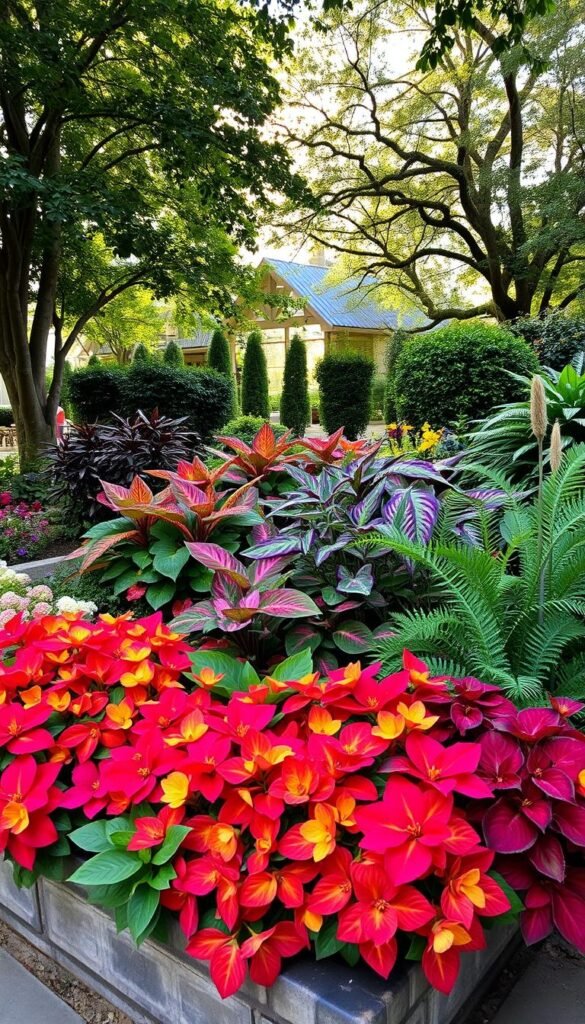
Shady areas become colorful canvases with the right annual selections. These temporary stars deliver months of visual impact, transforming dim corners into lively displays from spring’s first warmth until autumn’s chill.
Leaf Patterns That Outshine Flowers
The polka dot plant steals the show with confetti-like foliage in pink, red, or white speckles. Reaching 16-22 inches tall, it thrives equally in sun or shade. Pair it with Surefire Begonias – drought-tolerant bloomers that flower relentlessly under trees or porches.
For bold texture, ColorBlaze Coleus varieties explode with marbled leaves in sunset hues. Their 3-foot spreads fill containers quickly without constant pruning. “These foliage champions eliminate deadheading hassles,” notes a Maryland nursery owner.
Keeping the Color Coming
Most shade-loving annuals demand less upkeep than sun varieties. Water when soil surfaces dry, and feed monthly with balanced fertilizer. Catalina Torenia’s snapdragon-like blossoms in purple and yellow last all summer if you remove spent flowers weekly.
Pro tip: Use self-watering pots in deep shade to maintain consistent moisture. Rotate containers monthly to prevent lopsided growth from filtered light sources.
Essential Perennials to Enhance Your Shady Space
Transform shadowy spots into enduring displays with plants that return stronger each year. Perennials offer structure and reliability, anchoring your container designs while requiring minimal upkeep. Their evolving textures and colors keep arrangements fresh across seasons.
Heartleaf Brunnera: Nature’s Silver Lining
Brunnera ‘Jack of Diamonds’ brings drama with dinner-plate-sized leaves splashed in metallic patterns. These shimmering beauties thrive in full shade and moist soil, blooming with delicate blue flowers in spring. At 14-16 inches tall, they form lush mounds perfect for mid-height layers.
Goatsbeard: Feathery Flourishes
Towering at 30 inches, Aruncus ‘Chantilly Lace’ creates airy accents with creamy plumes. Its fern-like foliage stays crisp even in deep shade. Space this spreader 4 feet apart—or let it cascade from large containers for woodland charm.
Coral Bells: Color That Never Quits
Heuchera ‘Wild Rose’ packs punchy purple foliage that glows like stained glass. Compact 8-inch leaves pair well with taller companions, while summer flower spikes add vertical pops. It handles dry spells once established, perfect for forgetful waterers.
| Plant | Height | Spread | Zones | Key Feature |
|---|---|---|---|---|
| Heartleaf Brunnera | 14-16″ | 28-32″ | 3-8 | Silver-patterned leaves |
| Goatsbeard | 30-32″ | 40-48″ | 3-7 | Creamy flower plumes |
| Coral Bells | 8-10″ | 26-30″ | 4-9 | Rosy-purple foliage |
Mix these perennials for layered interest. Pair Brunnera’s bold leaves with Goatsbeard’s wispy texture and Heuchera’s rich hues. Remember: mature sizes matter—give root systems room to expand for healthier plants.
Incorporating Bold Foliage and Unique Textures
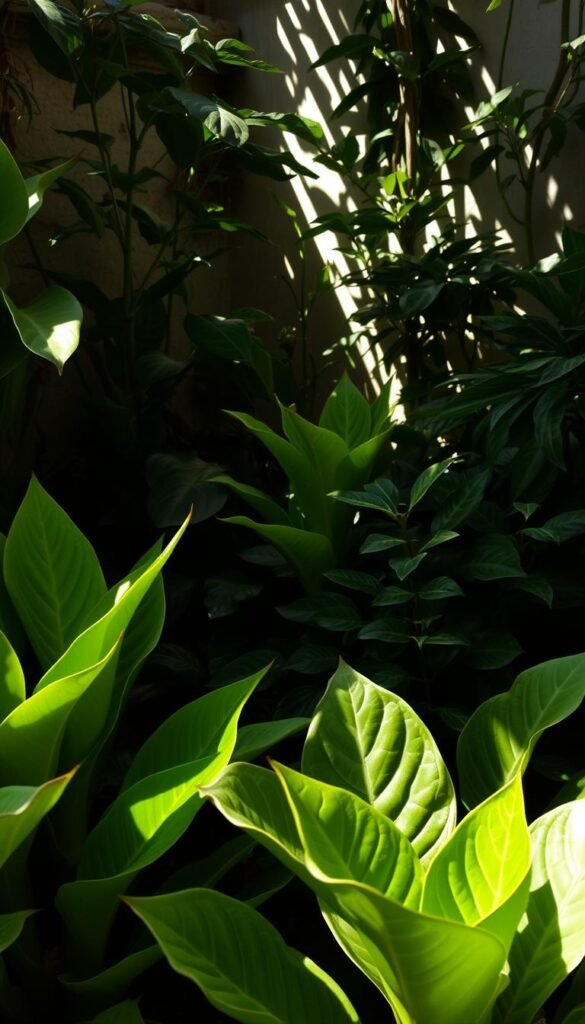
Shady corners become vibrant showcases when you play with leaf shapes and patterns. Foliage-focused designs keep containers lively even when flowers fade, offering year-round visual punch through strategic texture pairings.
Coleus, Caladium, and Other Foliage Stars
Heart to Heart Caladium transforms spaces with tropical flair. Its arrowhead-shaped leaves reach 15-20″ tall, splashed with pink, white, or red veining. These summer bulbs thrive in morning sun and afternoon shade, making them perfect porch companions.
ColorBlaze Coleus varieties explode with color contrasts. From neon lime to deep merlot, their serrated leaves create living mosaics. “These plants grow so vigorously, you’ll need to pinch them back weekly,” shares a Texas horticulturist. Their 24-36″ spread fills containers quickly.
| Plant | Light Needs | Height | Color Options |
|---|---|---|---|
| Caladium | Part shade | 15-20″ | Pink/White/Red |
| Coleus | Shade to sun | 18-36″ | Chartreuse/Burgundy |
| Rex Begonia | Full shade | 12-18″ | Silver/Green/Purple |
Combine broad caladium leaves with spiky ferns for dynamic texture. Try placing silver-patterned varieties beside deep purple heucheras. For shade garden design ideas, layer taller plants behind trailing ivy to create depth.
Remember: variegated leaves brighten dark corners better than flowers. Use them as living spotlights in north-facing rooms or under trees. Rotate pots monthly to ensure even growth patterns.
Smart Planting Tips and Container Strategies
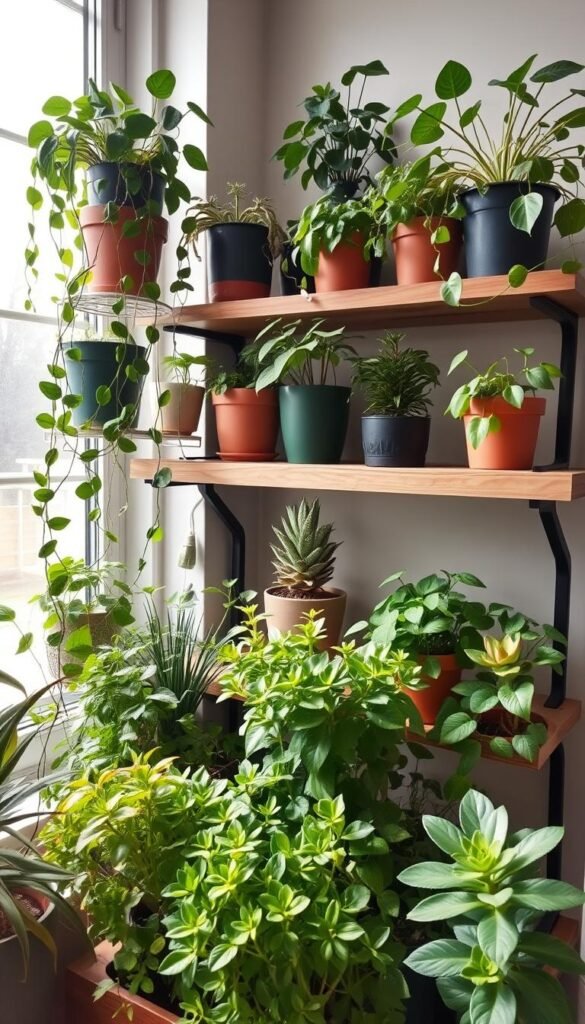
Mastering container design transforms shaded areas into lush retreats. The right approach balances aesthetics with practical care, creating displays that flourish despite limited sunlight. Let’s explore techniques to maximize your success.
Designing Container Gardens for Limited Sunlight
Choose pots with drainage holes and moisture-retaining materials like glazed ceramic. These help roots stay hydrated without becoming waterlogged. Thriller-filler-spiller arrangements work wonders: position tall begonias at the center, surround them with polka dot plants, and let ivy cascade over edges.
Group species with similar water needs. Ferns and mosses pair well in damp setups, while succulents prefer drier mixes. “Shade containers need 25% less watering than sun pots,” notes a Brooklyn plant stylist. Use this to your advantage during busy weeks.
Planning Your Garden Layout for Maximum Impact
Arrange containers based on growth rates. Slow-growers like coral bells can nestle close together initially. Leave 2-3 inches between plants that spread quickly. Rotate pots monthly to ensure even exposure to filtered light.
Create portable displays using lightweight resin planters. Move them as trees lose leaves or gain canopy coverage. This flexibility lets you chase shifting sun patterns while maintaining visual harmony on patios or balconies.
| Container Type | Best For | Maintenance Level |
|---|---|---|
| Unglazed Terra Cotta | Dry shade plants | High (frequent watering) |
| Self-Watering Pots | Moisture lovers | Low |
| Hanging Baskets | Trailing varieties | Medium |
Full Shade vs. Partial Sun: Matching the Right Plants
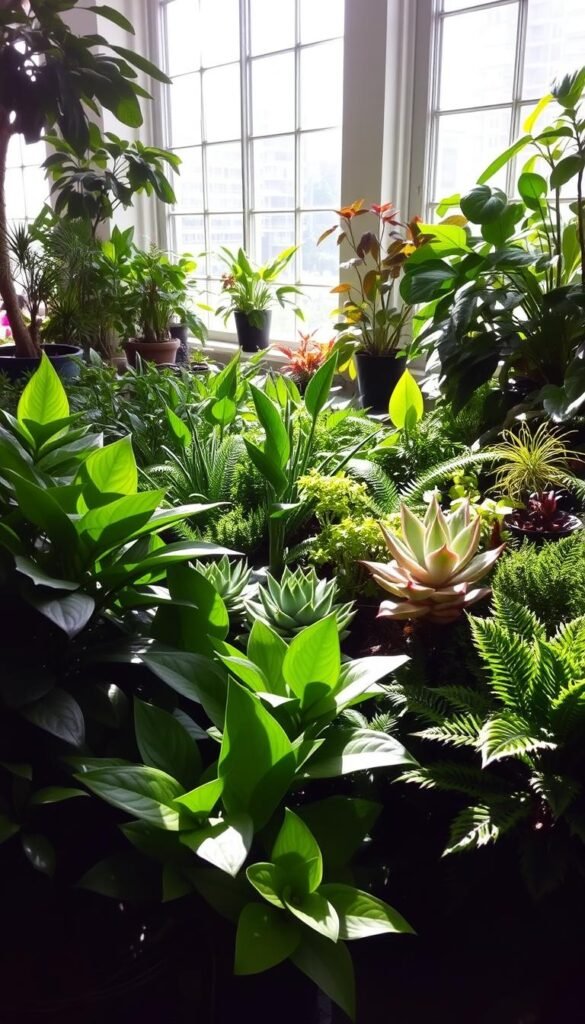
Did you know your morning sun behaves differently than afternoon sun? This simple truth changes everything when pairing plants with their ideal spots. Light intensity varies dramatically based on timing and duration—factors that determine whether your green friends flourish or struggle.
Identifying Plant Needs and Sunlight Hours
Start by tracking light patterns for 3 days. Use this cheat sheet:
- Full sun: 6-8 direct hours (best for tomatoes, rosemary)
- Partial shade: 4-6 filtered hours (ideal for hostas, impatiens)
- Full shade: Less than 4 hours (fern and moss territory)
Morning light offers gentle warmth perfect for delicate leaves. Afternoon rays bring intense heat—some plants love it, others fry. A Boston fern thrives in east-facing windows but wilts in western exposure.
Shade-tolerant varieties like coral bells adapt better than strict sun-lovers. “Many herbs actually prefer dappled light in hot climates,” reveals a USDA zone chart. Always cross-check plant tags with your microclimate—what works in Portland might fail in Phoenix.
| Light Type | Hours | Best Plants |
|---|---|---|
| Full Sun | 6-8 | Rosemary, Lavender |
| Partial Shade | 4-6 | Begonias, Ferns |
| Full Shade | <4 | Moss, English Ivy |
Remember: light changes with seasons. A spot that gets full sun in June might become shaded by November. Observe year-round before committing permanent plantings.
Low-Light Dish Garden Ideas: Plants That Thrive in Shady Corners
Designing for dim spaces unlocks nature’s adaptability. Many species evolved under tree canopies, developing strategies to flourish without direct sunlight. Your challenge lies in curating these natural performers into cohesive displays that captivate year-round.
Plant Selection Criteria for Shade-Loving Varieties
Focus on foliage first. Leaves become the main event in shadowy spaces, with shapes ranging from heart-shaped hostas to lacy ferns. Seek varieties offering triple-season appeal—spring blooms, summer texture, and autumn color shifts.
Consider growth habits carefully. Compact coral bells work well in small containers, while spreading ivies soften edges. “Prioritize plants that maintain form when light-starved,” advises a Missouri botanical garden curator. Avoid species needing seasonal pruning to thrive.
Comparing Annuals and Perennials in Shady Conditions
Annuals like coleus deliver instant drama with neon-bright leaves. They fill space quickly but require replacement each year. Perennials such as astilbe grow slower but establish enduring structure, often expanding their presence annually.
| Type | Pros | Cons | Best For |
|---|---|---|---|
| Annuals | Quick color | Yearly replanting | Seasonal themes |
| Perennials | Long-term growth | Slower establishment | Foundational designs |
Mix both types strategically. Use annuals as temporary accents between perennial anchors. This approach maintains visual interest while allowing your garden to evolve over time.
Shade Gardening for Edible Harvests
Who says shady spots can’t produce tasty treats? Many kitchen favorites flourish without full sun, letting you harvest fresh ingredients from dim areas. Herbs like mint and parsley thrive in dappled light, while leafy greens such as spinach develop tender leaves protected from harsh rays.
For bolder flavors, try growing ginger or wasabi—both naturally adapt to forest floor conditions. These plants often prefer moist, rich soil, so mix in compost before planting. Swiss chard offers dual benefits with colorful stems and edible leaves that brighten up shadowy containers.
Don’t forget mushrooms! Oyster varieties grow happily on logs tucked under trees. Pair them with shade-tolerant nasturtiums for peppery blooms that spice up salads. Water consistently but avoid soggy soil—most edibles prefer steady moisture over wet feet.
Your shaded nook could become a secret snack station. Experiment with combinations that suit your space and palate. With smart choices, even the darkest corners yield delicious rewards.

